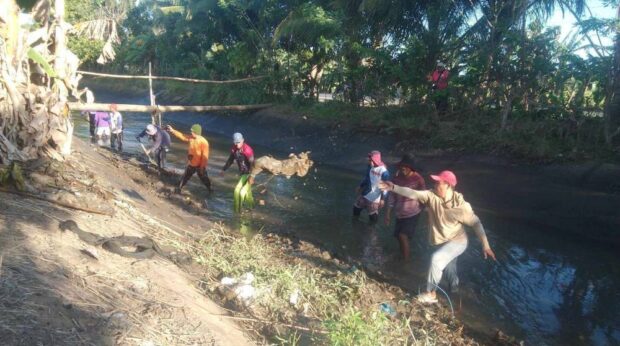Drought gripping Negros Occidental, says Pagasa

CANAL CLEARING | Farmers clear the irrigation system in Bago City, Negros Occidental, on March 1, 2024, to ensure adequate water supply for their crops amid the drought. (CONTRIBUTED PHOTO)
BACOLOD CITY, Negros Occidental, Philippines — Negros Occidental has been officially categorized as having been affected by drought, the only province in the Visayas that has been so far placed in that category as the absence of rainfall spawned by the El Niño weather phenomenon continues to be felt in many parts of the country.
The province is currently experiencing a drought or three consecutive months of way below normal rainfall conditions or more than 60-percent reduction from the average, according to the Philippine Atmospheric, Geophysical and Astronomical Services Administration (Pag-asa) Visayas report dated Feb. 29.
On the other hand, provinces that are considered to be under a “dry spell” are Antique, Iloilo, Capiz, and Guimaras in Western Visayas; Cebu and Negros Oriental in Central Visayas; and Leyte, Biliran, and Eastern Samar in Eastern Visayas. A dry spell is defined as three consecutive months of below-normal rainfall conditions.
P55-M damage
Classified to be under a “dry condition” are the provinces of Bohol and Siquijor in Central Visayas and Southern Leyte in Eastern Visayas for having experienced two consecutive months of below-normal rainfall conditions, the Pagasa said.
In Negros Occidental, the damage due to rice and corn crops attributed to the El Niño phenomenon now stood at P55,412,924, with Kabankalan City as the hardest hit, acting provincial agriculturist Dina Genzola said.
Article continues after this advertisementShe said the damage has affected 1,213 farmers tilling crops on 1,064 hectares, with rice crops valued at P55,255,071,89 lost to the drought, and corn at P157,852.80.
Article continues after this advertisementGov. Eugenio Jose Lacson earlier said the provincial government was considering cloud seeding to induce rains over affected agricultural lands.
The weather bureau said a drought could adversely affect different climate-sensitive sectors, including water resources, agriculture, energy, health, and public safety.
READ: Calamity state likely in Negros Occidental town if El Nino persists
However, Bago City and its neighboring areas appeared to have been spared from the effects of El Niño.
There are 12,000 hectares of rice crops under the Bago River Irrigation System (BRIS) that are doing well and producing six tons of rice per hectare.
BRIS covers the cities of Bago, La Carlota, and Bacolod and the towns of Murcia, Pulupandan, San Enrique, and Valladolid.
On March 1, farmers in Bago cleared the main canal of BRIS to ensure adequate water supply for their fields, provincial administrator Rayfrando Diaz said.
According to Diaz, only the rainfed rice lands are affected and farmers there were warned not to plant during the drought.